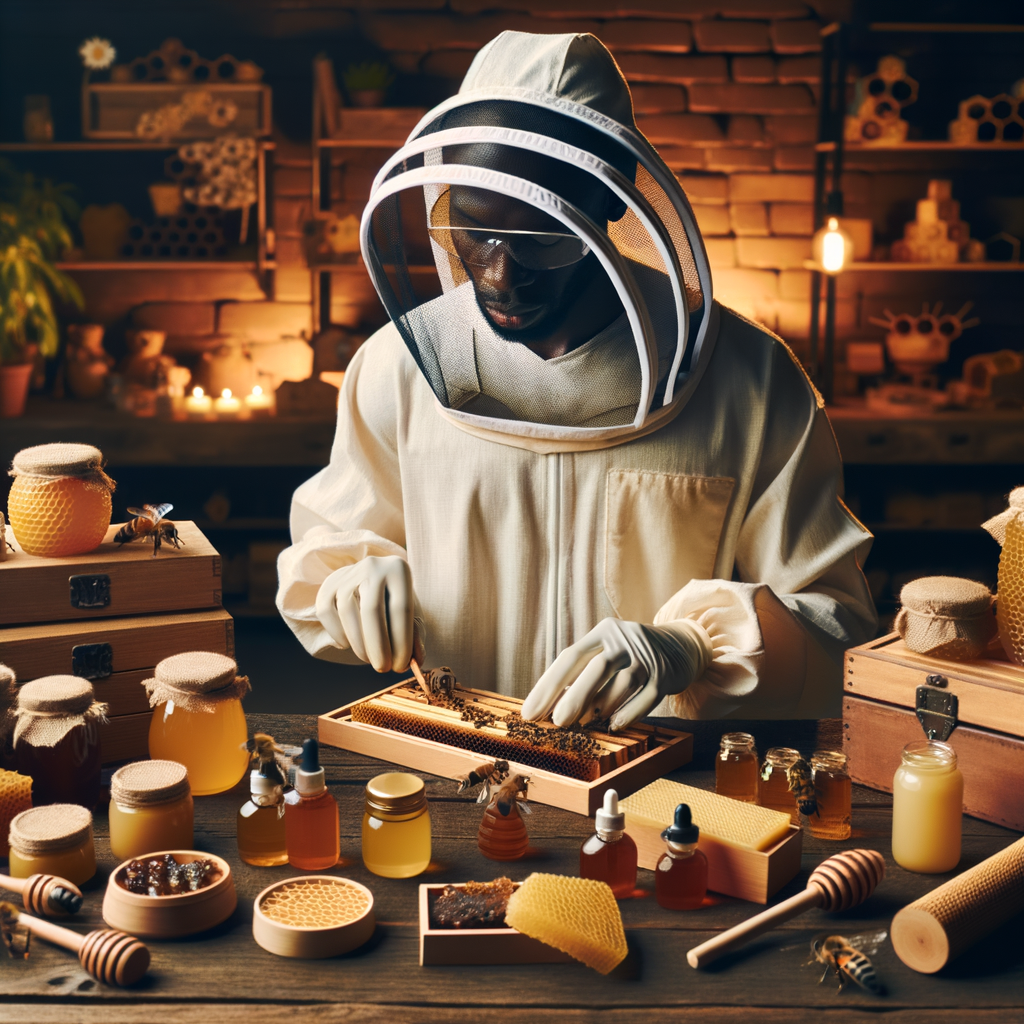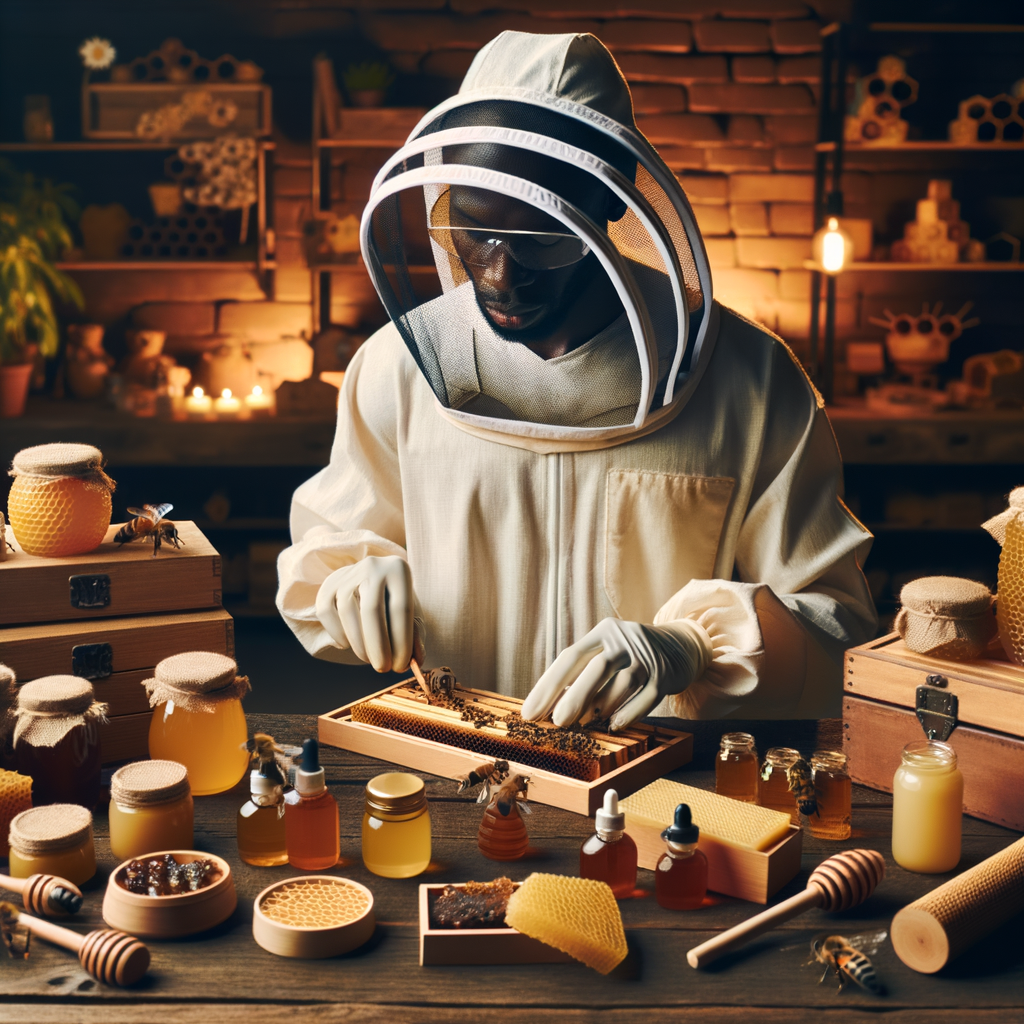
Introduction to Hive By-Products
When we think of bees, honey often comes to mind first. But bees produce more than just honey. They create a variety of other products, known as hive by-products, that are equally important and beneficial. In this section, we will delve into the concept of hive by-products and their significance in beekeeping.
-
- Understanding the concept of Hive By-Products
Hive by-products are the substances that bees produce in addition to honey. These include beeswax, propolis, pollen, and royal jelly. Each of these by-products has its own unique properties and uses. For instance, beeswax is used in making candles and cosmetics, propolis has medicinal properties, pollen is a nutritious food source, and royal jelly is used as a dietary supplement and in skincare products.
-
- Importance of Hive By-Products in beekeeping
Hive by-products play a crucial role in beekeeping. They not only provide additional income for beekeepers but also add value to the beekeeping industry. For instance, beeswax and propolis are highly sought after in various industries, including cosmetics, pharmaceuticals, and food. This demand creates a lucrative market for beekeepers. Furthermore, by-products like pollen and royal jelly are essential for the health and survival of the bee colony. They provide the necessary nutrients for the bees and are crucial for the queen bee’s development and reproduction.
In the following sections, we will explore the different types of hive by-products, their uses, and how beekeepers can leverage them to enhance their beekeeping practices and increase their income.
Types of Beehive Products
Bees are not just producers of honey. They create a variety of other products that are beneficial to humans. Let’s explore some of these incredible beehive products.
-
Honey and its by-products
Honey is the most well-known product from beehives. It’s a sweet, golden liquid made by bees using the nectar of flowering plants. Honey is not only delicious but also packed with nutrients and antioxidants. It’s used in a variety of food and medicinal products.
But honey isn’t the only product bees produce. They also create by-products such as honeycomb, a natural wax structure where bees store honey. Honeycomb is edible and often used in gourmet foods. Bees also make bee bread, a mixture of pollen and honey, which is a superfood packed with proteins and vitamins.
-
Beeswax and its uses
Beeswax is another valuable product from beehives. Bees produce this natural wax to build their honeycomb cells. Humans have found numerous uses for beeswax. It’s used in products like candles, cosmetics, food wraps, and even in the production of furniture polish and crayons. Beeswax is appreciated for its natural, non-toxic qualities.
-
Pollen, Propolis, and Royal Jelly
Bees collect pollen, a powdery substance from flowers, which is a rich source of proteins and vitamins. It’s often sold as a dietary supplement. Propolis is a resin-like substance bees use to seal their hives. It has antibacterial and anti-inflammatory properties and is used in various health products.
Royal Jelly is a creamy substance produced by worker bees. It’s used to feed the queen bee and larvae. Royal Jelly is known for its health benefits and is often used in dietary supplements and beauty products.
These are just a few examples of the diverse range of products bees produce. Each one has unique properties and uses, making bees an essential part of our ecosystem and economy.
Value Addition in Beekeeping
One of the most exciting aspects of beekeeping is the potential for value addition. This means taking the raw products that bees produce and transforming them into something more valuable. Let’s explore this concept further.
Creating Hive Products
Creating hive products involves more than just collecting honey. It’s about understanding the full potential of what a hive can produce and how to maximize its value.
-
- Transforming raw hive products into value-added products
Raw hive products such as honey, beeswax, and propolis can be transformed into value-added products. This process involves refining, packaging, and marketing these products in a way that increases their value. For example, raw honey can be bottled and labeled as organic, local, or specialty honey, increasing its market value. Beeswax can be used to create candles, lip balms, and other beauty products. Propolis, a resinous substance collected by bees, has medicinal properties and can be used in health supplements.
-
- Case study: Successful value addition in beekeeping
Let’s look at a real-life example of successful value addition in beekeeping. A small beekeeping business in Vermont, USA, started with just a few hives and sold raw honey at local farmers’ markets. Recognizing the potential for value addition, they began to create beeswax candles and honey-infused skincare products. Today, their products are sold in stores across the country, and they have significantly increased their revenue.
Value addition in beekeeping is not just about making more money. It’s also about sustainability and making the most of our natural resources. By creating value-added products, beekeepers can support their local economy, promote biodiversity, and contribute to a healthier planet.
Hive Product Utilization
Coming up next, we will delve into the various ways hive products can be utilized, from food and beverages to health and beauty products. Stay tuned!
Hive Product Utilization
Bees are not only known for their honey, but they also provide other products that are used in various industries. Let’s explore how these hive products are utilized.
Beehive By-Product Uses
Bees produce more than just honey. Their hives are a source of many by-products that have numerous uses in different industries. Here are some key examples:
- Use of honey by-products in the food industry: Honey is a natural sweetener that is used in a wide range of food products. It’s not just the sweetness that makes honey a popular choice in the food industry, but also its health benefits. Honey is rich in antioxidants and can help improve digestion. Moreover, it is used in baking, cooking, and beverage industries due to its ability to retain moisture and enhance flavors.
- Use of beeswax in the cosmetic industry: Beeswax is another valuable by-product of beehives. It is widely used in the cosmetic industry due to its moisturizing and smoothing properties. Beeswax is a key ingredient in lip balms, lotions, and makeup products. It forms a protective barrier on the skin, helping to lock in moisture without clogging pores.
- Medical uses of propolis and royal jelly: Propolis and royal jelly are two other by-products from beehives that have significant medical uses. Propolis, also known as bee glue, has antibacterial, antiviral, and anti-inflammatory properties. It is used in a variety of health products and supplements. Royal jelly, on the other hand, is a substance that bees produce to feed their queen. It is packed with nutrients and is often used in dietary supplements and skincare products due to its potential health benefits.
In conclusion, beehive products are not only beneficial for the bees themselves but also for various industries. They offer a natural and sustainable solution for many needs, from food to cosmetics to health care. The utilization of these products is a testament to the incredible value of bees and their hives.
Bee Product Innovation
In the world of beekeeping, innovation is key. It’s not just about honey anymore. Beekeepers and businesses are finding new and exciting ways to use hive by-products, creating valuable products that are both beneficial and sustainable. Let’s explore some of these innovative uses and a case study of successful bee product innovation.
Transforming Hive By-Products into Valuable Creations
When we think of bees, honey is usually the first thing that comes to mind. However, bees produce more than just honey. They also produce wax, pollen, propolis, and royal jelly, all of which have unique properties and potential uses.
-
- Innovative uses of hive by-products
Beekeepers and businesses are finding innovative ways to use these hive by-products. For example, beeswax is being used in a variety of products, from candles and cosmetics to food wraps and furniture polish. Propolis, a resin-like substance bees use to seal their hives, is being used in natural health products due to its antibacterial and anti-inflammatory properties. Even bee pollen is being harvested as a health food supplement, packed with proteins, vitamins, and minerals.
-
- Case study: Successful bee product innovation
One company that has successfully innovated with bee products is Bee’s Wrap. They’ve created a sustainable alternative to plastic wrap using beeswax, organic cotton, tree resin, and jojoba oil. This product is reusable, biodegradable, and compostable, making it a great option for eco-conscious consumers. Since its launch, Bee’s Wrap has been a hit, showing that innovation with hive by-products can lead to successful and sustainable businesses.
In conclusion, the world of bee product innovation is buzzing with potential. By finding new and creative uses for hive by-products, we can create products that are not only valuable but also sustainable and beneficial for our planet. The future of hive by-products is bright, and we can’t wait to see what innovative creations will come next.
Conclusion: The Future of Hive By-Products
As we reach the end of our exploration into the world of hive by-products, it’s clear that the future holds immense potential. The beekeeping industry is not just about honey production anymore. It’s about the myriad of other by-products that can be derived from the hive and their potential uses. Let’s summarize the key takeaways and look at the future of value-added products in beekeeping.
-
- Key takeaways on hive by-product utilization
Throughout this article, we’ve learned that hive by-products are not just waste materials. They are valuable resources with a wide range of applications. Beeswax, for instance, is used in cosmetics, candles, and even in food processing. Propolis, on the other hand, is known for its medicinal properties and is used in health supplements and natural remedies. Even bee pollen and royal jelly are superfoods with numerous health benefits.
-
- The potential future of value-added products in beekeeping
The future of beekeeping lies in the innovative use of these by-products. As consumers become more conscious about natural and sustainable products, the demand for hive by-products is set to increase. Beekeepers can leverage this trend by diversifying their offerings and adding value to their products. For instance, they could produce beeswax candles, propolis tinctures, or even skincare products made from royal jelly. This not only increases their income but also contributes to a more sustainable and eco-friendly world.
As we continue to discover new uses for these natural resources, the possibilities are endless. So, the next time you enjoy a spoonful of honey, remember that it’s just the tip of the iceberg when it comes to the wonders of the beehive.








